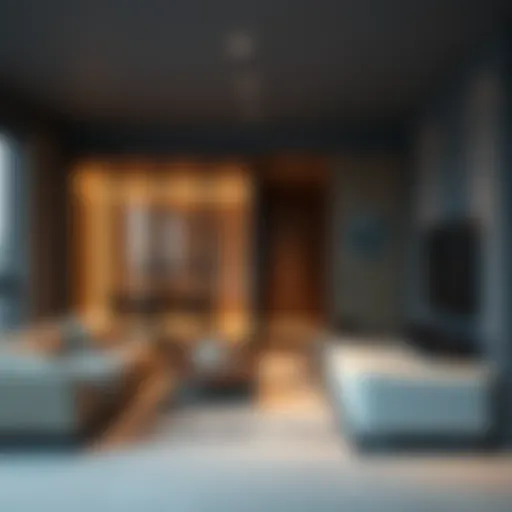Discovering Souk Naif: Dubai's Cultural Marketplace
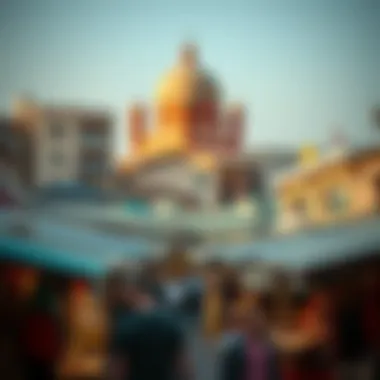

Intro
Souk Naif stands as a vibrant testament to Dubai's cultural and economic essence. Nestled amid the city's bustling life, this traditional marketplace invites both locals and visitors to experience its unique offerings. From exquisite textiles to authentic spices, Souk Naif presents an opportunity to dive into the past while witnessing the contemporary dynamics of a marketplace evolving under the pressures of modernity.
As we explore this legendary souk, we will uncover its role in preserving the heritage of Dubai while also revealing its significance in the real estate landscape. The juxtaposition of old-world charm against the backdrop of a rapidly developing city makes Souk Naif not just a market, but a cultural epicenter that connects various eras.
In the sections that follow, we will navigate through key market trends, investment insights, and the allure that Souk Naif holds for investors, expatriates, and entrepreneurs alike. This guide intends to enlighten and equip you with information crucial to understanding the dynamics surrounding this iconic hub.
Market Trends
The magical blend of tradition and modernity at Souk Naif has an undeniable influence on the local market trends. Investors and expats eyeing Dubai's real estate must pay heed to the shifts and forecasts shaping this vibrant landscape.
Current Property Prices and Forecasts
Today, property prices in and around Souk Naif have shown a mixed performance. While some areas nearby have skyrocketed in cost due to ongoing developments, others still offer affordable options for first-time investors. According to recent reports, properties within a one-kilometer radius of the souk are experiencing steady appreciation, largely due to their proximity to popular amenities and tourist attractions.
Forecasts indicate a potential rise in property values over the next few years as demand increases. Investors should keep an eye on the following:
- Proximity to established commercial entities
- Infrastructure developments, such as new transport links
- Increased foot traffic from tourism
Popular Neighborhoods and Emerging Areas
While the souk itself is a draw, nearby neighborhoods are also emerging as attractive spots for investment. Areas like Deira and Al Rigga are often highlighted for their blend of residential and commercial properties. Al Nakheel and Al Muraqqabat are also gaining traction, with a growing number of expatriates seeking residences that offer a taste of local culture blended with modern conveniences.
Emerging areas further afield, such as Dubai Creek Harbour, are signaling growth opportunities as developers set their sights on crafting new commercial and residential experiences. Investors should consider diversifying into these upcoming locales while keeping an eye on Souk Naif for its unyielding charm and historical significance.
Investment Insights
Investing in Dubai’s property landscape, particularly around cultural hubs like Souk Naif, presents unique opportunities. Here, there's not just financial returns to consider but also the essence of being involved in a thriving community steeped in heritage.
Tips for New Real Estate Investors
For those who are new to the scene, here are some pointers to keep in mind:
- Research extensively: Knowing both historical context and current market trends can help you identify potential opportunities.
- Network locally: Engaging with local real estate agents and attending community events can provide invaluable insights.
- Evaluate property types: Consider various property types—residential, commercial, or mixed-use—to find what best fits your goals.
- Understand regulations: Familiarize yourself with local laws and regulations governing property investments in Dubai.
Benefits of Investing in Dubai Properties
Investing in properties within Dubai, particularly in culturally rich areas such as Souk Naif, comes with numerous advantages:
- Tax Benefits: Dubai offers attractive tax structures for property owners.
- Cultural Value: Properties near heritage sites are often viewed positively, creating a potential increase in value.
- Global Investors Welcome: Dubai’s open-door policy to foreign investment makes it easier for international buyers to enter the market.
Navigating these insights can transform a typical investment into a remarkable journey rooted in culture and business. With its lively souks, distinctive architecture, and a constantly evolving marketplace, Souk Naif serves as a thriving indicator of Dubai's ongoing story, making it a crucial stop for anyone interested in the emirate's real estate potential.
Historical Background of Souk Naif
Understanding the historical backdrop of Souk Naif is crucial to appreciating its role in Dubai's cultural and economic landscape. This marketplace, established decades ago, not only serves as a shopping destination but also as a living testament to the city’s rich heritage and evolution over time. By delving into its origins and subsequent transformations, we can gain insights into how traditional markets adapt in the face of modernization while still retaining their essence.
The Origins of Souk Naif
Souk Naif traces its roots to the early days of Dubai, a place that always relied on trade as a lifeblood. Originally, this area was more than just a market; it was a meeting point for merchants from various backgrounds, creating a vibrant tapestry of cultures and goods. What started as a modest gathering of traders and craftsmen has blossomed into a bustling hub, known for its authenticity and charm.
In the heart of the market, one can find artisans selling handmade wares, spices, textiles, and traditional garments that harken back to a slower, more thoughtful time. The origins reflect a community spirit, one that encourages small businesses and local craftsmanship. It is this unique blending of history and commerce that imparts a special value to Souk Naif.
Evolution Through the Years
As Dubai grew, so did Souk Naif. The evolution of this souk mirrors the broader changes in Dubai itself—from a traditional trading port to a global crossroads of business and tourism. In the mid-20th century, the souk began to witness infrastructural enhancements, adapting to a growing influx of customers. Nonetheless, these changes were carefully curated to preserve the marketplace’s traditional character.
Over the years, the introduction of modern facilities, such as improved access for tourists and enhanced vendor stalls, helped balance the old with the new. Events and festivals highlighting cultural heritage have also proliferated within the souk's walls, bridging the gap between past and present.
Despite the rapid changes surrounding it, Souk Naif remains a cultural bastion. Today, it continues to attract a diverse crowd—both locals who cherish their heritage and tourists looking to soak in the authentic flavors of Dubai. Thus, its journey from humble origins to a renowned market encapsulates the resilience and adaptability of traditional commerce in a world increasingly leaning towards digital solutions.
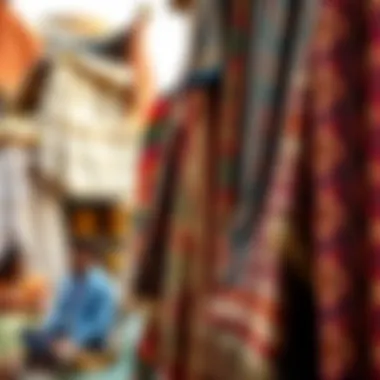

Architectural Features
Architectural features play a pivotal role in understanding the essence of Souk Naif. The design elements reflect not just the aesthetic choices of the past but also the cultural identity of the community. When wandering through the souk, one cannot help but notice how the architecture tells a story, bridging tradition with the demands of modernity. This blend not only enhances the visual experience but engages visitors on a deeper cultural level. By examining the architectural landscape, investors are able to appreciate the unique value propositions of Souk Naif, which might influence economic opportunities and investment potential.
Traditional Design Elements
The traditional design elements of Souk Naif are steeped in history. The craftsmanship visible in the intricate woodwork and the use of natural materials not only speak to a time when artisans were valued, but also evoke a sense of nostalgia.
- Wind Towers: These architectural marvels, known as barjeel, provided air conditioning long before the invention of modern HVAC systems. They are a testament to the ingenious ways architects met practical needs with elegance.
- Mashrabiya Screens: These wooden latticework screens add both beauty and privacy, allowing cool breezes while filtering harsh sunlight.
- Clay and Limestone Finishes: The use of local materials in construction kept structures aligned with the environment, providing a unique character that modern materials often miss.
Visitors will find themselves drawn into this special world where past meets present, creating an unforgettable experience. The thoughtful arrangement of the stalls amidst traditional corridors offers a sense of community, welcoming both locals and tourists into its embrace.
Modern Enhancements
In contrast to the traditional aspects, modern enhancements to Souk Naif introduce a fresh perspective while preserving the core identity of the marketplace. These upgrades not only improve functionality but also attract a broader audience.
- LED Lighting: This not only illuminates the souk after dark but also enhances its nighttime appeal. The warm glow casts a softer light on traditional motifs, creating a magical atmosphere.
- Smart Technology Integration: Modern amenities, like Wi-Fi hotspots, improve the shopping experience for tech-savvy consumers who want to stay connected while they explore.
- Renovated Walkways: The upgrade of pathways contributes to accessibility, allowing individuals of all ages and abilities to navigate comfortably.
These enhancements act as a bridge between the rich heritage of the souk and the vibrancy of today’s commerce, making it a relevant hub for current and future generations. Visitors can appreciate both the essence of the trade that flourished in the past alongside the convenience modernity brings to the marketplace.
As the marketplace evolves, maintaining the balance between heritage and innovation becomes essential, shaping the destinies of those who walk its corridors.
Cultural Significance
Souk Naif stands not merely as a marketplace but rather as a cultural mosaic that reflects the rich heritage of Dubai. Its significance stretches far beyond commerce to embody the essence of local traditions and communal bonds. The souk plays an essential role in preserving not just goods but also stories, connecting generations through shared experiences. Visitors here are not just shoppers; they become partakers in a living history, where the past meets the present in vibrant interactions.
Preservation of Heritage
The preservation of heritage at Souk Naif is a key element that showcases the link between the past and the bustling present. As Dubai hurtles into the future with skyscrapers and modern developments, Souk Naif serves as a reminder of the city’s origins. This traditional marketplace allows artisans and local vendors to keep age-old crafts alive, showcasing products that range from handmade textiles to intricate jewelry. Because of such dedication, the essence of the Emirati culture is maintained, giving local people pride in their rich history.
The market's architecture itself is steeped in history, mimicking the traditional wind towers and mud-brick designs of a bygone era. This intentional architectural homage invites nostalgia and offers tourists a glance into the realm of authentic Dubai, distinct from merely flashy shopping malls. Without such preservation efforts, much of the unique character of the city could be overshadowed by contemporary developments.
"Cultural marketplaces like Souk Naif serve as the heart of the community, beating in rhythm with history while adapting to the ever-changing economic landscape."
Cultural Activities and Events
Walking through Souk Naif, one can expect a spirited display of cultural activities that draw both locals and tourists alike. The market regularly hosts events that highlight local art, music, and culinary delights, embedding the souk deeper into Dubai's cultural fabric. For instance, during Ramadan, one might find lively evening bazaars filled with performances of traditional music and dance, inviting visitors to join in the celebrations.
Such events not only entertain but also educate; they reveal the traditions that form the backbone of Emirati society. Culinary workshops might teach how to prepare traditional dishes, further engaging visitors in a hands-on experience with local culture. These activities cultivate a sense of community while also enticing tourists to immerse themselves in the cultural milieu of Dubai.
Moreover, festivals centered around crafts and artisanal goods provide opportunities for local artisans to connect with an international audience. They create avenues for dialogue about preservation, identity, and innovation, emphasizing the value of cultural heritage in a rapidly modernizing society.
Commercial Dynamics
The commercial dynamics at Souk Naif contribute significantly to its identity as both a vibrant market and a fundamental economic entity in Dubai. This section examines the various factors that affect trade, sales, and consumer behavior within the souk, shedding light on the unique aspects that distinguish it from other retail spaces in the city. For investors and entrepreneurs, understanding these dynamics is crucial for recognizing potential opportunities in one of Dubai's most culturally infused marketplaces.
Types of Goods Available
Souk Naif is a treasure trove of products that cater to a diverse clientele. This marketplace is known for its authentic Arabian crafts, textiles, and spices. You can find an eclectic mix of goods, including:
- Traditional emirati attire, such as kanduras and abayas.
- Handcrafted jewelry and trinkets that reflect local craftsmanship.
- Irresistibly fragrant spices and herbs, perfect for culinary enthusiasts.
- Artisan products such as woodwork and handmade pottery.
The variety of goods is both a boon and a challenge for vendors. With many unique items, traders must continually adapt to market demands and customer preferences. The blending of local craftsmanship with imported goods also speaks to the globalization of the market, appealing to both residents and tourists.
Local vs. Tourist Preferences
When it comes to preferences, there tends to be a divergence between locals and tourists. Local residents often seek products that reflect their cultural heritage and practical needs, whereas tourists are usually on the lookout for souvenirs, exotic items, and experiences that encapsulate the essence of Dubai.
- Locals might favor traditional textiles and spices, often purchasing in larger quantities for personal and family use.
- Tourists, on the other hand, might gravitate toward unique, memorable items such as Arabic perfumes or intricate jewelry to take home.
Understanding these diverse preferences is vital for merchants aiming to optimize their sales strategies. Adjusting inventory to meet the different demands allows vendors to maximize their appeal and remain competitive in this bustling marketplace.
A careful balance between local preferences and tourist demands can lead to increased revenue and sustained business growth within Souk Naif.
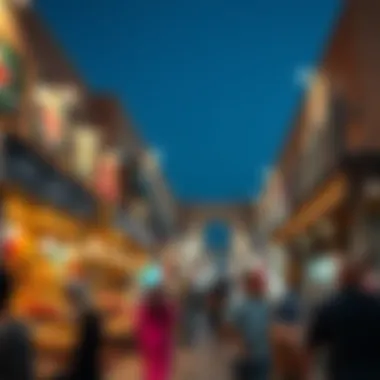

Visitor Experience
The Visitor Experience in Souk Naif stands as a cornerstone of its allure, knitting together a tapestry of vibrant sights, sounds, and tastes. For those wandering through its bustling aisles, this souk serves not just as a marketplace, but as a narrative woven with culture and history, reflecting the heart of Dubai. Understanding the nuances of this experience can provide keen insights for investors and expatriates alike, enhancing their engagement with this cultural gem.
Navigating the Souk
Navigating Souk Naif can feel like a journey through a time capsule. With its narrow pathways, vendors beckoning from every corner, and the aromatic scent of spices wafting through the air, it offers an immersive exploration. Some tips for first-timers include:
- Wear comfortable shoes: The souk is vast, and walking is a key part of the experience.
- Stay hydrated: With the warm climate, it’s wise to carry water.
- Engage with vendors: The sellers are often eager to share stories about their goods, allowing for a deeper appreciation of what lies behind the crafts.
Getting lost in the winding alleys is not only inevitable but also part of the allure. Each turn might unveil a new treasure, whether it's exquisite textiles, intricate handicrafts, or unique souvenirs. Such exploration fosters a real connection with the local culture, enriching the travel experience.
Dining Options and Local Cuisine
Souk Naif is not just about shopping; it’s a feast for the senses, and the dining options reflect the rich local cuisine. The souk boasts a variety of eateries that offer everything from quick snacks to more elaborate meals. Key highlights include:
- Shawarma stands: Quick, flavorful, and fulfilling, these local treasures are a must-try for any visitor.
- Hummus and falafel shops: These staple dishes provide a taste of traditional Arabic flavors, often found in various forms across stalls.
- Sweets and pastries: Don't miss out on desserts like baklava or kunafa, often garnished with honey and nuts.
Dining in Souk Naif immerses visitors further into its vibrant atmosphere. Sharing a meal can encourage conversations with locals, fostering a greater understanding of shared experiences. In fact, here’s a tip: for a unique adventure, try to sample street food — it's often where one can find the most authentic flavors.
“Eating at a souk isn’t just about satisfying hunger; it’s about community, stories, and tradition.”
With every bite, a glimpse into the culinary history of Dubai is revealed, showcasing the marriage of local ingredients and time-honored techniques.
In essence, the Visitor Experience in Souk Naif encapsulates what makes Dubai's cultural tapestry so rich. From navigating the vibrant stalls to savoring local dishes, each aspect represents a thread in a larger narrative that continues to evolve while honoring its roots.
Economic Role in Dubai
Souk Naif is not just a throwback to a bygone era but serves as a pivotal cog in the wheel of Dubai's economy. In this bustling marketplace, visitors and locals alike can find a treasure trove of goods, from traditional textiles to handmade crafts. The role this souk plays extends beyond mere commerce; it embodies the essence of cultural preservation while stimulating economic growth.
Impact on Local Economy
The impact of Souk Naif on the local economy is multifaceted, weaving together threads of cultural heritage and commercial viability. Here, small businesses flourish, and vendors, often family-owned, showcase the very spirit of entrepreneurship. This marketplace generates employment opportunities, offering jobs to a diverse group of individuals ranging from artisans to vendors. As these businesses thrive, they contribute to job creation, thus vitalizing the community.
Financially, Souk Naif acts as a magnet for both tourists and locals who are drawn to its lively atmosphere. People flock to the market, not just to shop but to immerse themselves in an authentic cultural experience. This influx of visitors translates into increased spending, which benefits not only the vendors but also surrounding establishments. Restaurants, cafes, and retail shops experience a positive ripple effect, amplifying the economic dynamics of the neighborhood.
Moreover, the souk holds a significant place in Dubai’s unique economic structure where traditional markets coexist with modern retail outlets. This blend attracts a varied clientele, ensuring consistent foot traffic, which is crucial for sustaining economic vitality. Strategically, businesses within Souk Naif adapt to meet the demands of today's consumers, balancing tradition with modern trends—all while echoing the history of the region.
Investment Opportunities
Investing in Souk Naif can be seen as a gateway to tapping into Dubai's broader economic landscape. For investors, the souk represents an opportunity to acquire unique artisanal products that are increasingly sought after in both local and international markets. There is a growing appreciation for craftsmanship, leading to a demand for the type of goods offered at this marketplace. Therefore, partnering with local artisans or setting up shop can yield fruitful returns.
Furthermore, as Dubai continues to position itself as a global hub, the real estate surrounding Souk Naif is witnessing upward trends. Demand for residential and commercial property is surging, fueled by an influx of expatriates and tourists alike. This surge presents investment opportunities not only for buying property but also for supporting related businesses.
"Real estate is a veritable goldmine around cultural hotspots, and Souk Naif is no exception."
In summary, Souk Naif is more than just a market—it is an economic powerhouse that underscores the synergy between culture and commerce in Dubai. For investors and entrepreneurs, understanding this dynamic can open doors to exciting avenues, all while engaging with a rich cultural tapestry. As this iconic souk continues to evolve, the potential for economic growth remains insatiable, promising numerous opportunities for those who dare to enter the fray.
Real Estate Trends Influenced by Souk Naif
When it comes to understanding the ever-evolving landscape of Dubai's real estate, one cannot overlook the profound impact of Souk Naif. As a cultural touchpoint, this traditional marketplace lays the foundation for various trends that shape both residential and commercial property in the area. In a city known for its sky-high towers and extravagant developments, Souk Naif maintains a unique charm that draws in investors and residents alike, making it a focal point worth discussing.
Surrounding Developments
The vicinity of Souk Naif is characterized by a blend of modern architecture and cultural authenticity. As the souk operates, there’s a ripple effect on the surrounding real estate market. New developments such as Al Ghurair Centre showcase contemporary living, while still paying homage to the traditional marketplace that sits nearby.
- Flagship Projects: The deployment of luxury apartments and hotels adjacent to Souk Naif has been a strategic move. Residents seeking the vibrancy of a marketplace nearby find convenience and local experience in their day-to-day lives.
- Revamped Infrastructure: Roads surrounding Souk Naif have seen improvements, allowing for better accessibility. The enhanced transport links encourage both foot traffic and client visits, further stimulating property prices in the nearby districts.
In essence, the revitalization of the area around Souk Naif creates a synergy between modern living and traditional market experiences, making it all the more appealing for potential buyers.
Market Demographics
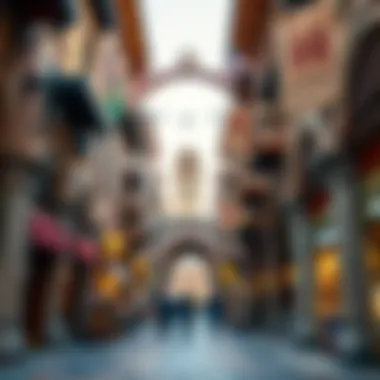

Understanding the demographics of the market surrounding Souk Naif gives investors sharper insight into potential growth areas. The blend of local Emirati culture with an influx of expatriates creates a unique purchasing power dynamic that is pivotal for real estate strategies.
- Foreign Investors: A significant percentage of buyers in the area are expatriates looking for both investment opportunities and homes that reflect their lifestyles.
- Local Residents: Conversely, local Emiratis appreciate the proximity to cultural sites and see value in properties that connect them to their heritage.
- Age and Income Distribution: The age demographic skews younger, with professionals and families who prefer urban living. This group often seeks amenities that blend leisure and convenience, driving demand for properties that provide access to both.
In summary, as Souk Naif continues to attract attention, the market dynamics shift accordingly. The cultural vibrancy of the souk directly influences real estate viability, making it an essential marker for those keen on tapping into Dubai's lucrative property market.
Future of Souk Naif
The future of Souk Naif is a significant aspect of its ongoing relevance in Dubai's vibrant marketplace. As the city evolves and adapts to new economic pressures and cultural shifts, the souk stands at a crossroads, embodying the need for a balance between tradition and modernity. Preserving its identity while appealing to new generations of residents and visitors is no small feat, but it is essential for maintaining its role as a cultural and commercial hub.
Challenges Facing Traditional Markets
Like many traditional markets in the age of increasing digitalization, Souk Naif faces a number of challenges that threaten its longevity. Factors such as changing consumer behavior, the rise of e-commerce, and urban development can put pressure on brick-and-mortar establishments.
Some of the most pressing issues include:
- Competition from Online Retail: Customers increasingly turn to online platforms for their shopping needs due to convenience and lower prices. Souk Naif must find ways to compete and entice customers to visit in person.
- Changing Demographics: As Dubai attracts a diverse population, the traditional charm of the souk may not resonate with all. New residents may have different shopping preferences that favor contemporary malls over traditional marketplaces.
- Urban Development: With the rapid development of Dubai’s infrastructure and the expansion of commercial areas, the souk could face pressure from newer shopping destinations that offer modern amenities.
These challenges necessitate innovative solutions to ensure that Souk Naif remains a preferred destination.
Adaptation Strategies
In responding to these pressures, Souk Naif can employ several adaptation strategies that leverage its unique strengths while embracing new opportunities:
- Enhanced Customer Experience: By improving the shopping experience with interactive displays, cultural performances, and events, the souk can draw in more visitors. Experiences that engage the senses often linger in memory longer than the transaction itself.
- Online Integration: Many traditional markets are finding ways to incorporate an online presence. Creating a website or app that allows customers to preview goods, order online, or learn about special events could connect customers better with the souk.
- Cultural Programming: Establishing regular cultural activities—like workshops in local crafts, cooking classes showcasing Emirati cuisine, or storytelling sessions—could enhance the visitor experience and create a compelling reason to visit.
Implementing these strategies could serve as a strong foundation for Souk Naif's future, transforming challenges into opportunities that enhance its role within Dubai's economic landscape.
The fusion of tradition and modern adaptation will be key for Souk Naif to flourish in the evolving market landscape of Dubai.
The success of these initiatives will be indicative of the broader trend in preserving cultural identity in the face of relentless urbanization and modernization. Those invested in the future of Souk Naif will be keeping a close eye on how these strategies unfold, especially as they seek to bridge the gap between the old and the new.
Comparative Analysis with Other Souks
Understanding Souk Naif in the broader context of Dubai's marketplace ecosystem is pivotal for investors, expatriates, and entrepreneurs. This comparative analysis not only highlights its distinct features but also brings to light key aspects that set it apart from other souks in the region. Festivals, local traditions, and small business trends often play a major role in how these marketplaces evolve. Hence, recognizing these elements can provide a clearer view of Souk Naif's stand in the bustling city of Dubai.
Souk Madinat Jumeirah
Souk Madinat Jumeirah, a strikingly modern interpretation of traditional Arab marketplaces, offers a unique experience that caters primarily to upscale tourists and expatriates. Unlike Souk Naif, which passionately retains its heritage, Souk Madinat leans heavily on luxury retail and fine dining. Its meandering waterways and opulent architecture draw visitors seeking an aesthetic atmosphere and high-end shopping.
- Product Range: Souk Madinat is packed with boutiques showcasing luxury brands, art galleries, and gourmet food options. Visitors can savor world-class dining experiences coupled with picturesque views, differentiating it greatly from the vibrant, everyday shopping dynamics of Souk Naif.
- Cultural Experience: While both souks offer a glimpse into Dubai's rich culture, Souk Madinat does so through a lens of leisure and opulence, whereas Souk Naif is more aligned with everyday life, offering visitors a chance to see and experience local customs and daily interactions.
Although both souks cater to varied audiences, their coexistence enriches Dubai's cultural landscape immensely. Here, travelers can find both luxurious relaxation and a bustling local marketplace.
Gold Souk
On the other hand, the Gold Souk provides a stark contrast to Souk Naif. Renowned globally for its incredible selection of gold jewelry, this souk attracts not only tourists but also serious buyers looking for quality craftsmanship and competitive pricing.
- Focus on Jewelry: Unlike Souk Naif's diverse range of goods, featuring textiles, spices, and traditional crafts, the Gold Souk specializes in a singular product that draws attention. With over 300 retailers under one roof, visitors can find everything from intricate pieces to contemporary designs.
- Pricing and Investment Value: The Gold Souk represents a savvy option for investors, as gold remains a solid investment choice. The presence of numerous shops allows for price comparison and ensures that customers receive quality assurance, a feature that depends heavily on individual seller reputation in Souk Naif.
Gold Souk's allure as an investment hub differentiates it markedly from Souk Naif, which focuses more on cultural engagement and a bustling street market atmosphere.
Epilogue
The exploration of Souk Naif offers a window into not just a market but a vital thread woven into the cultural and economic fabric of Dubai. This conclusion not only summarizes the key takeaways but emphasizes how such cultural hubs contribute significantly to urban life and development. Souk Naif, with its vibrant atmosphere and rich history, does more than facilitate commerce; it serves as a gathering spot that fosters community ties and cultural identity.
Summarizing Key Insights
As discussed throughout this article, several informed insights emerge about Souk Naif:
- Historical Significance: The origins of Souk Naif date back to the early days of Dubai, marking it as a true testament to the city’s evolution. The souk has stood strong against the changing tides of modernity, preserving its character and traditions.
- Architectural Charm: The blend of traditional design with modern enhancements exemplifies the unique architectural identity of Souk Naif. Visitors can appreciate how the structures reflect both past influences and contemporary needs.
- Cultural Events: Regular events and festivals play an essential role in maintaining cultural vibrancy, attracting locals and tourists alike. Such activities not only engage the community but also contribute to the souk's economic vitality.
- Economic Contributions: The souk holds a pivotal place within Dubai’s broader economic landscape, supporting local businesses while catering to the demands of tourists.
- Real Estate Impact: Property trends surrounding Souk Naif reveal a growing interest among investors, highlighting its significance as a cultural and commercial cornerstone in the city.
"Cultural markets like Souk Naif are more than mere shopping destinations; they are the heartbeat of urban centers, reflecting the spirit and heritage of a people."
The Role of Cultural Markets in Urban Development
Cultural markets such as Souk Naif are instrumental in shaping the urban landscape. They serve several critical functions:
- Encouraging Local Business: Such souks support local artisans and craftspeople, ensuring a diverse economic ecosystem. By prioritizing local goods, they nurture economic sustainability.
- Preserving Heritage: As centers of culture and history, these markets help maintain traditional practices and local identities. Their very existence promotes awareness and appreciation for the cultural narratives that define communities.
- Enhancing Tourism: Cultural markets attract tourists, which fuels revenue not just for the market, but for surrounding businesses and services. This symbiotic relationship helps lift the entire area economically.



